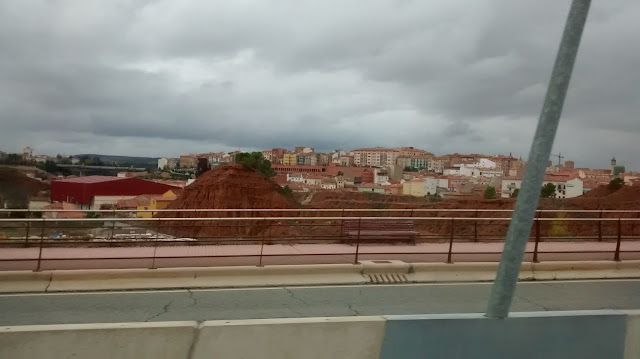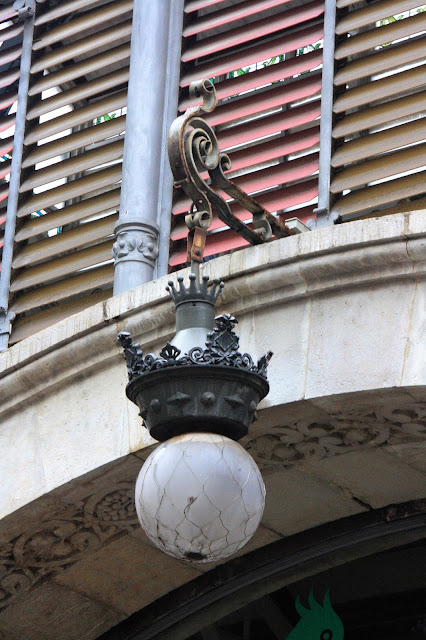Betera to Careñina, 169 miles Aire Careñina, free, 1 night.
The Valencia Camper stop is situated near Betera, a small town to the northeast of the city at the end of metro line 1. It's a little less than half an hour into the centre and also convenient for the motorway. After one last glimpse of a grey Mediterranean across a sprawl of factories and orange plantations, we turned north towards Teruel. For the first thirty kilometres or so the road climbs steadily across the southern edge of the Sierra d'Espada until it levels out at an altitude of 1000 metres which it then maintains, more or less, until it reaches Zaragoza in the Ebro valley, 250 kilometres to the north.
The scale of Spain's central plain has a grandeur that feels more North American than European. At times it can be a monotonous drive, but it is not without interest, partly because it is punctuated by Sierras which appear on the holizon from time to time as a chipped rim to the shallow bowl of high plains. Also, the colours change constantly reflecting the variable geology. For example, Teruel occupies a low mudstone bluff in a small valley. The rock formations and the soil are startlingly reddish, ranging in tone from a dark blood orange to burnt umber. It is very beautiful.
 |
| Red rocks around Teruel |
We had planned to stay overnight here, but you make good progress on the empty inland roads of Spain and we arrived by early afternoon. We found a Repsol station and filled up with diesel and LPG. Muriel directed us to the aire; it's in a modern suburb next to a large Social Security office building, more a car park than an official moho stop, but there were two other vans squeezed into the small bays so I guess overnighting is tolerated. Usefully, there is a large Mercadona around the corner. We bought some groceries, had a Greek salad for lunch, and it was still early afternoon. Though our guidebook mentioned that Teruel had an interesting old centre, we decided to press on. The city did look inviting as we caught a glimpse of it from the 'ronda'. It straggles along the edge of a red rock escarpment, the pale stone towers of the cathedral poking up from a cluster of pink stuccoed palacio. The entire landscape looks decidedly sanguine.
 |
| A glimpse of Teruel, another time perhaps.... |
To the north the prospect is less colourful, especially as the treeless wheat prairies lie fallow right now. Under the fading light of a dull afternoon we crossed the muted patchwork of empty fields, a landscape painted in mauve, beige and lovat.
 |
| Early afternoon - grey roads and red rock; later - red roads and grey rock...and bad modern sculpture to relieve the boredom. |
Only when we began to climb towards a pass near Panzina did the scenery become more variable, small clumps of trees with pale grey trunks dotted the hillsides, some autumnal, others bare and wintery. Here the Autovia Mujedar reaches the southern rim of the Ebro valley. As we dropped down towards our destination, the wine town of Cariñena, as you might expect the lower slopes were carpeted with vines of differing varieties, some bright yellow, others almost tangerine, and smaller patches that were bare, their black trunks gnarled with a few sere leaves hanging motionless in the still air of a chilly evening.
Cariñena is a workaday small agro-industrial town with a older centre, but mainly consisting of utilitarian terrace houses and small industrial buildings connected to the wine trade and grain storage. The aire situated next to the sports hall, it is well designed and the services well maintained - which is exacrly what you need.
We had spotted a bodega with a shop that seemed open - very little else did seem open - so we donned scarves and cagoules to see what we could buy. Our Hugh Johnson handbook mentioned that Cariñena is the only DOC where the name of the area is the same as a grape variety - so we headed of into Cariñena in search of a bottle of Cariñena made purely from Cariñena.
We had spotted a bodega with a shop that seemed open - very little else did seem open - so we donned scarves and cagoules to see what we could buy. Our Hugh Johnson handbook mentioned that Cariñena is the only DOC where the name of the area is the same as a grape variety - so we headed of into Cariñena in search of a bottle of Cariñena made purely from Cariñena.
 |
| Eureka moment - a bottle of Cariñena made purely from Cariñena... |
One of the aspects of Spain that makes you happy is the generally personable and pleasant demeanour of its people. Almost universally they are positive and outgoing and do their utmost to help visitors. Of course there is always going to be exceptions, and the person at the till in the bodega achieved a level of total misery worthy of a British Post Office counter clerk whose pet poodle, that very morning, had come to a sudden, untimely demise. Of course it could be that the Senora had just received some devastating news, so really you cannot judge, but she was spectacularly downbeat.
We bought the bottle Cariñena made purely from Cariñena to take home, but we drank it later that evening and got our best wine buff bullshit out, 'soft fruits, but with a flinty edge' we decided. We can't double check, the other bottles we bought were less expensive mixed grape types with a Temporilla base - like Rioja, which in truth is only just up the road.
e
e



















































